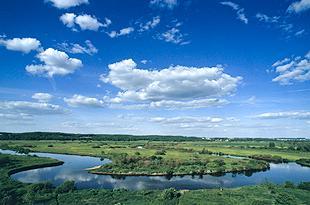Rivers

A river forms a continuum, along which many parameters change: discharge, current, sediment and temperature, food sources as well as species composition. Small mountain rivers mainly have single channels, more downstream the channel changes to braided and meandering patterns.
Rivers are closely interlinked with their floodplainArea adjacent to a river periodically inundated. Floodplains act as hydrological buffers during floods and droughts and provide a main energy source (e.g. leaves, wood, terrestrial insects) for the river macroinvertebrate community and ultimately for the fish.
Like all other aquatic ecosystems in Europe river systems have been changed for decades or even centuries by a multitude of impacts. Nevertheless, small streams in mountain areas remained relatively undisturbed; many have never been severely polluted as opposed to the majority of large rivers. Physical alterations, however, affect most European rivers and their catchments. Longitudinal and lateral connectivity are largely disturbed and interactions between the stream and its terrestrial surrounding are disrupted.
Obviously, climate change will worsen this situation by changing discharge regimes and increasing water temperatures and associated parameters in many European regions. It will contribute to a general upstream shift of river zones, particularly affecting species bound to small streams and springs, which cannot move further upstream. Most fish of small rivers, especially the salmonids, are cold-adapted and will be particularly affected by rising temperatures.